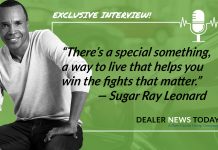
By Desiree Homer
A lot has changed for dealers in the industry over the last several months. And by change, we’re not talking subtle operational nuances. Dealers are facing fundamental shifts at every level of operations, processes, and sales. President of the Russ Darrow Auto Group, Mike Darrow, talked to Dave Cantin about these industry changes in a recent Dealer News Today podcast episode. His family-owned, successful dealership group in Wisconsin didn’t shutter during the pandemic. Darrow’s insights and strategy thus far, has proven to be successful. Outside distractions play a role in how individuals make purchasing decisions. Darrow says, “there is nothing we can’t or won’t do,” when discussing his philosophy for keeping in step with demand and customer preferences. The pandemic has created a retail environment ripe for creative solutions as dealers learn how to pivot their efforts in new directions.
When the Customer Wants a Boat
If a customer comes into the dealership expressing interest in buying a boat, your savvy salesperson would probably transition the conversation to identify the need for a vehicle to pull that boat. Customers today may be feeling distracted, like Mike Darrow says. It may be the time for dealers to focus on reminding customers that they need the truck to pull the boat, figuratively. Customer engagement needs to be able to cut through the communication noise and distractions to offer real solutions. Funneling car buyers back to the market, albeit in more of a digital and remote buying set of channels, means identifying the customers’ needs and providing easy, next step solutions. It may be worth getting back to basics in terms of sales.
Sell Me This Pen & the Old Fashioned Four-Square
When Johnny Carson asked Zig Ziglar to sell him this ashtray, Ziglar responded by saying he would, but first would need to know what the ashtray was worth to Carson. Carson said he guessed it would be worth about $20, to which Ziglar replied, “sold.” Similarly, and more recently featured in The Wolf of Wallstreet, the ‘sell me this pen’ theory shares the same worth-driven sentiment.
When reminiscing back to sales before the pandemic, and even a more recent burst of online selling techniques, you may recall the four-square. Sitting down with car buyers who have selected a vehicle, ready to negotiate the numbers, meant identifying the pain points and objections. Each of the four squares, usually drawn out on paper for visual effect, represented pillars of the deal – the purchase price, a trade-in value, the money down amount, and the estimated monthly payment. Almost immediately, the customer would respond to the one or more squares that caused them to pause. If the customer only objected to the trade-in value square, the salesperson wouldn’t spend time trying to negotiate the other pillars. Instead, the manager might intercede, offer a more robust trade-in value, and close the deal. As old fashioned as the technique is, it is still a testament to the importance of identifying the customer need first and then selling to that need specifically.
What Hasn’t Changed About Sales
People still need vehicles to work, play, and commute, and they only want those vehicles they afford. Despite the methods and channels used, the core sentiments are the same. While many dealers are revamping their virtual buying platforms and reinventing their marketing approaches, understanding what car buyers need remains the objective on the sale front.
- Remembering names, details, and family members with every engagement is key.
- Asking the right questions will uncover the objectives and needs.
- Avoid disparaging conversations about politics, competitors, management, etc.
- Car sales is about trust and relationship building. Be honest, transparent, and helpful.
- Don’t forget to ask for the sale, the testimonial, and the referral.
Customer Needs Have Changed, So Should Your Solutions
Mike Darrow talked about being thankful he was still able to do his Friday fish fry events at his dealerships, during the heat of the pandemic mitigation efforts. Those fish fry’s seemed to be what hist customers needed, too. It’s a reminder that today’s consumer will have different needs, and the dealers positioned to meet those needs will continue to cultivate those relationships and ultimately sell cars. For Darrow, maintaining a consistent community presence kept his dealerships plugged into his local market. Various regions of the country were forced to shut down, and dealers in those areas branched out to offer local support and partner with area businesses for community connection.
People will still need their trucks for work, fuel-efficient cars for the commute, and minivans for growing families. But how they browse, inquire, engage, and buy may present entirely different preferences. They’ll still want to test drive. So, dealers are shifting to offer delivery services that allow consumers to sample vehicles from home. Individuals want hassle-free negotiating and are far more educated on inventory and values. To adapt, dealers offer simplified, online processes for trade-in valuation and all-inclusive pricing. In today’s pandemic environment, dealer owners who can anticipate those changes, and create solutions accordingly, will continue to succeed.
When customers want to buy boats, dealers who recognize the opportunity to sell those customers, the trucks and SUVs needed to pull those boats will continue to be resilient in these unprecedented times. Many dealer owners are looking for new ways to find those new needs and then reworking their sales process. The four-square model hasn’t changed, but the values in each of those squares may have.


















